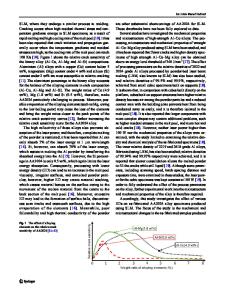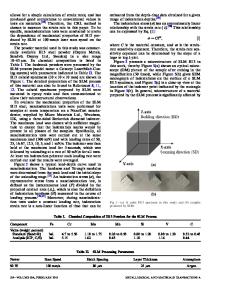Influence of post-heat treatments on the mechanical properties of CX stainless steel fabricated by selective laser melti
- PDF / 3,544,577 Bytes
- 14 Pages / 595.276 x 790.866 pts Page_size
- 64 Downloads / 347 Views
Influence of post-heat treatments on the mechanical properties of CX stainless steel fabricated by selective laser melting Cheng Chang1,2, Xingchen Yan3,4,5,*, Rodolphe Bolot4,5, Julien Gardan1,2, Shuohong Gao4,5, Min Liu3, Hanlin Liao4,5, Mahdi Chemkhi1,2, and Sihao Deng4,5 1
ICD-LASMIS, UMR CNRS 6281, University of Technology of Troyes, 12 rue Marie Curie, CS 42060, 10004 Troyes Cedex, France EPF, Ecole d’ingenieurs, 2 rue Fernand Sastre, Troyes, France 3 National Engineering Laboratory for Modern Materials Surface Engineering Technology, The Key Lab of Guangdong for Modern Surface Engineering Technology, Guangdong Institute of New Materials, Guangzhou 510651, People’s Republic of China 4 ICB-PMDM, UMR 6303, CNRS, Univ. Bourgogne Franche-Comté, UBFC, 71200 Le Creusot, France 5 UTBM, 90010 Belfort, France 2
Received: 11 February 2020
ABSTRACT
Accepted: 12 March 2020
High-performance CX stainless steel was successfully manufactured using selective laser melting (SLM) technology, and different types of post-heat treatments were adopted for ameliorating the mechanical properties of as-built specimens. The microstructure evolution process (i.e., cell structures, cellular dendritic grains and blocky grains containing substructures) was explained using the rapid solidification theory after SLM. Nanoprecipitates and their hardening behavior in the SLM CX stainless steels in the as-built and solutionaged state were detected by transmission electron microscope (TEM). The results of high-resolution TEM showed that the massive needle-like nanoprecipitates with a size range of 3–25 nm (as-built sample) and 7–30 nm (solutionaged sample) were evenly distributed in the martensite matrix. In the meantime, the strengthening mechanism was analyzed and discussed. Moreover, various post-heat treatments exhibited a great influence upon the mechanical performances of the SLM CX stainless steel samples. The average micro-hardness of the SLM CX stainless steel parts was found to extremely improve from 357 HV0.2 (as-built sample) to 514 HV0.2 (solution-aged sample). On the contrary, the total impact energy (Wt) of the SLM CX stainless steel parts decreased from 83.8 J in the as-built condition to 5.3 J in the solution-aged condition.
Ó
Springer Science+Business
Media, LLC, part of Springer Nature 2020
Address correspondence to E-mail: [email protected]
https://doi.org/10.1007/s10853-020-04566-x
J Mater Sci
Introduction Precipitation hardening stainless steel (PHSS), evaluated and denominated by their materials hardening ability after post-heat treatments, is a type of Fe–Cr– Ni alloy containing one or more kinds of precipitation hardening elements, e.g., Al, Ti, Mo, Cu, Nb [1, 2], etc. The high strength and hardness of the PHSS can be attained by the fine and evenly distributed intermetallic compounds [such as Ni3 (Al, Ti, Mo), e-Cu, Ni3Nb, NiAl, Laves phases (AB2) and carbides] within the matrix after the precipitation hardening procedure. The brilliant mechanical performances can be achieved by a simple aging treatment a
Data Loading...











